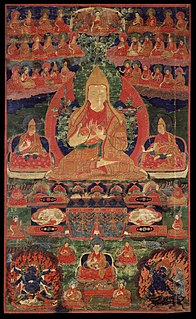This biography of a living person needs additional citations for verification .(April 2011) (Learn how and when to remove this template message) |
Gareth Sparham is a scholar and translator in the field of Tibetan Buddhism.
This biography of a living person needs additional citations for verification .(April 2011) (Learn how and when to remove this template message) |
Gareth Sparham is a scholar and translator in the field of Tibetan Buddhism.
Born in Britain, Gareth Sparham lived as a Buddhist monk among the Tibetan exile community of Dharamsala, India, for twenty years, and studied through the Institute of Buddhist Dialectics from 1974 to 1982. Sparham earned his Ph.D. in 1989 from the University of British Columbia. He retired from his position as a lecturer in the Department of Asian Languages and Cultures of the University of Michigan in 2009. [1]

Tibetan Buddhism is the form of Buddhism practiced in Tibet and Bhutan, where it is the dominant religion. It also has adherents in the regions surrounding the Himalayas, in much of Central Asia, in the Southern Siberian regions such as Tuva, and in Mongolia.

Padmasambhava, also known as Guru Rinpoche , incarnated as a fully enlightened being, as foretold by Buddha Shakyamuni. Padmasambhava is considered the Second Buddha by the Nyingma school, the oldest Buddhist school in Tibet known as "the ancient ones". Around 767 he came to Tibet and helped construct Samye Monastery, the first Buddhist and Nyingma monastery in Tibet. Padmasambhava then revealed the Vajrayana of Tibetan Buddhism, with scholars, translators, and masters. His students in Tibet include the great master Yeshe Tsogyal and the "Twenty-Five King and Subjects".

The Gelug is the newest and currently most dominant school of Tibetan Buddhism. It was founded by Je Tsongkhapa (1357–1419), a Tibetan philosopher, tantric yogi and lama.

The Kadam school of Tibetan Buddhism was founded by Dromtön (1005–1064), a Tibetan lay master and the foremost disciple of the great Bengali master Atiśa (982-1054). The Kadampa were quite famous and respected for their proper and earnest Dharma practice. The most evident teachings of that tradition were the teachings on bodhicitta. Later, these special presentations became known as lojong and lamrim by Atiśa.

Robert Alexander Farrar Thurman is an American Buddhist author and academic who has written, edited, and translated several books on Tibetan Buddhism. He was the Je Tsongkhapa Professor of Indo-Tibetan Buddhist Studies at Columbia University, before retiring in June 2019. "Robert Thurman held the first endowed chair in Buddhist Studies in the West." He also is the co-founder and president of the Tibet House US New York. He translated the Vimalakirti Sutra from the Tibetan Kanjur into English. He is the father of actress Uma Thurman.

Geshe Kelsang Gyatso is a Buddhist monk, meditation teacher, scholar, and author. He is the founder and former spiritual director of the New Kadampa Tradition-International Kadampa Buddhist Union (NKT-IKBU), an "entirely independent" modern Buddhist order that presents itself to be a tradition based on the teachings of the Gelugpa tradition of Tibetan Buddhism, which has grown to become a worldwide Buddhist organisation which claims to have 1,300 centers around the world, most study and meditation centers, with some retreat centers.
Lamrim is a Tibetan Buddhist textual form for presenting the stages in the complete path to enlightenment as taught by Buddha. In Tibetan Buddhist history there have been many different versions of lamrim, presented by different teachers of the Nyingma, Kagyu and Gelug schools. However, all versions of the lamrim are elaborations of Atiśa's 11th-century root text A Lamp for the Path to Enlightenment (Bodhipathapradīpa).

Tsongkhapa, usually taken to mean "the Man from Onion Valley", born in Amdo, was a famous teacher of Tibetan Buddhism whose activities led to the formation of the Gelug school of Tibetan Buddhism. He is also known by his ordained name Losang Drakpa or simply as "Je Rinpoche". Also, he is known by Chinese as Zongkapa Lobsang Zhaba, He was the son of a Tibetan Longben Tribal leader who also once served as an official of the Yuan Dynasty of China.

A ḍākinī is a type of female spirit or demon in Hinduism and Buddhism.

The New Kadampa Tradition – International Kadampa Buddhist Union (NKT—IKBU) is a global Buddhist new religious movement founded by Kelsang Gyatso in England in 1991. In 2003 the words "International Kadampa Buddhist Union" (IKBU) were added to the original name "New Kadampa Tradition". The NKT-IKBU is an international organisation registered in England as a charitable, or non-profit, company. It currently lists more than 200 centres and around 900 branch classes/study groups in forty countries.
The Svatantrika–Prasaṅgika distinction is a doctrinal distinction made within Tibetan Buddhism between two stances regarding the use of logic and the meaning of conventional truth within the presentation of Madhyamaka.

Thupten Jinpa Langri is a Tibetan Buddhist scholar, former monk and an academic of religious studies and both Eastern and Western philosophy. He has been the principal English translator to the Dalai Lama since 1985. He has translated and edited more than ten books by the Dalai Lama including The World of Tibetan Buddhism, A Good Heart: A Buddhist Perspective on the Teachings of Jesus, and the New York Times bestseller Ethics for the New Millennium.
The Three Roots of the Tibetan Buddhist tradition are the lama, yidam, and protector, which may be a khandroma or chokyong. The Three Roots are the second of three Tibetan Buddhist refuge formulations, the Outer, Inner and Secret forms of the Three Jewels. The 'Outer' form is the 'Triple Gem', (Sanskrit:triratna), the 'Inner' is the Three Roots and the 'Secret' form is the 'Three Bodies' or trikaya of a Buddha. These alternative refuge formulations are employed by those undertaking Deity Yoga and other tantric practices within the Tibetan Buddhist Vajrayana tradition as a means of recognizing the universality of Buddha Nature. The Three Roots are commonly mentioned in the Nyingma and Kagyu literature of Tibetan Buddhism. Unlike most aspects of Tibetan Buddhism, which originated in India, the Three Roots may be an original Tibetan formulation from the time of Padmasambhava. The functions of the Three Roots are:

Bruce Alan Wallace is an American author and expert on Tibetan Buddhism. His books discuss Eastern and Western scientific, philosophical, and contemplative modes of inquiry, often focusing on the relationships between science and Buddhism. He is founder of the Santa Barbara Institute for Consciousness Studies.

The Abhisamayālaṅkāra "Ornament of/for Realization[s]", abbreviated AA, is one of five Sanskrit-language Mahayana śastras which, according to Tibetan tradition, Maitreya revealed to Asaṅga in northwest India circa the 4th century AD. Those who doubt the claim of supernatural revelation disagree whether the text was composed by Asaṅga himself, or by someone else, perhaps a human teacher of his.
Tharpa Publications is "a major international and multilingual publisher of Buddhist books" by the Buddhist author and scholar Geshe Kelsang Gyatso. They are based in New York. These include basic Buddhist meditation books such as The New Meditation Handbook, books on the Buddhist way of life such as Universal Compassion, books on Buddhist philosophy and psychology such as Heart of Wisdom, and books on Buddhist Tantra. Tharpa Publications is a non-profit corporation that has operated for 25 years and claims to have sold over a million books. Waterhouse adds that the books "are distributed widely and may be seen on the shelves of popular booksellers as well as in university libraries."
The Madhyamakāvatāra is a text by Candrakīrti on the Mādhyamaka school of Buddhist philosophy. It is a commentary on the meaning of Nagarjuna's Mūlamadhyamakakārikā and the Ten Stages Sutra. As such, within the Tibetan Buddhist canon this text is classified as commentarial literature.

Khenpo Sodargye is one of the most eminent contemporary Buddhist masters, and was born in the eastern region of Tibet known as Kham in 1962. Khenpo is a Tibetan lama, a Buddhist scholar and teacher, a prolific translator into Chinese, and a modern Buddhist thinker renowned across Asia and the west for his interest in the integration of traditional Buddhist teachings with worldwide issues and modern life.
Gyurme Dorje was a Scottish Tibetologist and writer.
Ngawang Samten is a Tibetan educationist, Tibetologist and the vice chancellor of the Central University for Tibetan Studies. Besides editing publications such as Abhidhammathasamgaho, Pindikrita, Pancakrama and Manjusri, he is the co-translator of Je Tsongkhapa's commentary on Nagarjuna’s Mūlamadhyamakakārikā. The Government of India awarded him the fourth highest civilian honour of the Padma Shri, in 2009, for his contributions to Education.